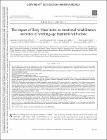| dc.contributor.author | Kelleher, John | |
| dc.date.accessioned | 2022-03-21T13:27:23Z | |
| dc.date.available | 2022-03-21T13:27:23Z | |
| dc.date.issued | 2021 | |
| dc.date.submitted | 2021 | en |
| dc.identifier.citation | García-Rudolph A, Kelleher JD, Cegarra B, Saurí Ruiz J, Nedumpozhimana V, Opisso E, Tormos JM, Bernabeu M., The impact of body mass index on functional rehabilitation outcomes of working-age inpatients with stroke, European Journal of Physical and Rehabilitation Medicine, 2021 Apr;57(2):216-226 | en |
| dc.identifier.other | Y | |
| dc.identifier.uri | http://hdl.handle.net/2262/98330 | |
| dc.description.abstract | Background: Stroke is the most relevant cause of acquired persistent disability in adulthood. The relationship between patient's weight during rehabilitation and stroke functional outcome is controversial, previous research reported positive, negative and no effects, with scarce studies specifically addressing working-age patients.
Aim: To evaluate the association between Body Mass Index (BMI) and the functional progress of adult (<65 years) patients with stroke admitted to a rehabilitation hospital.
Design: Retrospective observational cohort study.
Setting: Inpatient rehabilitation center.
Population: 178 stroke patients (ischemic or hemorrhagic).
Methods: Point-biserial and Spearman's correlations, multivariate linear regressions and analysis of covariance were used to describe differences in functional outcomes after adjusting for age, sex, severity, dysphagia, depression and BMI category. Functional Independence Measure (FIM), FIM gain, efficiency and effectiveness were assessed.
Results: Participants were separated in 3 BMI categories: normal weight (47%), overweight (33%) and obese (20%). There were no significant differences between BMI categories in any functional outcome (total FIM [T-FIM], cognitive [C-FIM]), motor [M-FIM]) at discharge, admission, gain, efficiency or effectiveness. In regression models BMI (as continuous variable) was not significant predictor of T-FIM at discharge after adjusting for age, sex, severity, dysphagia, depression and ataxia (R2=0.4813), significant predictors were T-FIM at admission (β=0.528) and NIHSS (β=-0.208). M-FIM efficiency did not significantly differ by BMI subgroups, neither did C-FIM efficiency. Length of stay (LOS) and T-FIM effectiveness were associated for normal (r=0.33) and overweight (r=0.43), but not for obese. LOS and T-FIM efficiency were strongly negatively associated only for obese (r=-0.50).
Conclusions: FIM outcomes were not associated to BMI, nevertheless each BMI category when individually considered (normal weight, overweight or obese) was characterized by different associations involving FIM outcomes and clinical factors.
Clinical rehabilitation impact: In subacute post-stroke working-age patients undergoing rehabilitation, BMI was not associated to FIM outcomes (no obesity paradox was reported in this sample). Distinctive significant associations emerged within each BMI category, (supporting their characterization) such as length of stay and T-FIM effectiveness were associated for normal weight and overweight, but not for obese. Length of stay and T-FIM efficiency were strongly negatively associated only for obese. | en |
| dc.format.extent | 216-226 | en |
| dc.language.iso | en | en |
| dc.relation.ispartofseries | European Journal of Physical and Rehabilitation Medicine; | |
| dc.relation.ispartofseries | 57; | |
| dc.relation.ispartofseries | 2; | |
| dc.rights | Y | en |
| dc.subject | Stroke | en |
| dc.subject | Body mass index | en |
| dc.subject | Independent living | en |
| dc.subject | Rehabilitation | en |
| dc.title | The impact of body mass index on functional rehabilitation outcomes of working-age inpatients with stroke | en |
| dc.type | Journal Article | en |
| dc.type.supercollection | scholarly_publications | en |
| dc.type.supercollection | refereed_publications | en |
| dc.identifier.peoplefinderurl | http://people.tcd.ie/kellehjd | |
| dc.identifier.rssinternalid | 239683 | |
| dc.identifier.doi | http://dx.doi.org/10.23736/S1973-9087.20.06411-4 | |
| dc.rights.ecaccessrights | openAccess | |




